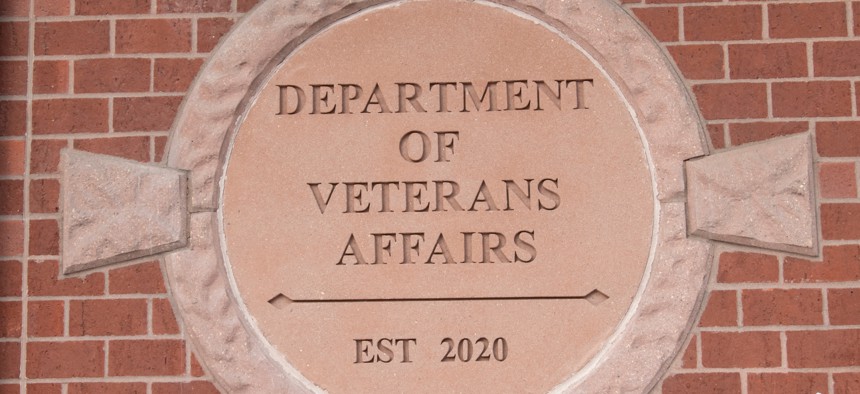
The Department of Veterans affairs logo on its building in Anoka, Minn. VA will focus all of its initial efforts solely on where it is currently falling short and should therefore build and expand capacity. Michael Siluk/Getty Images
VA Says Its Renewed Infrastructure Review Will Focus on Building First
Closures could still come, but that will be a "secondary matter."
The Veterans Affairs Department is once again evaluating its physical footprint after significant controversy forced it to abandon a previous effort, though it has promised to take a vastly different approach this time around.
In reviewing the capacity of its health care network, VA will focus all of its initial efforts solely on where it is currently falling short and should therefore build and expand capacity. Last year, Congress killed the Asset and Infrastructure Review (AIR) Commission it established under a 2018 law. That process, years in the making, sparked significant backlash from veterans, VA employees and lawmakers in both parties after it proposed shuttering dozens of hospitals and 172 outpatient clinics.
Congress ultimately defunded the commission before it could even begin its work after the Senate refused to confirm President Biden’s nominees for the panel, but VA vowed to modernize its network anyway. This time around, however, it will not consider closures until it identifies places to add new facilities.
“One advantage that we have now that we didn't necessarily have before is the fact that we can focus much more diligently and upfront on the build agenda,” Shereef Elnahal, VA’s undersecretary for health, told reporters on Thursday. “We can focus on the infrastructure that needs to exist in the first instance, before talking about closures of old facilities.”
Still, the undersecretary did not rule out potential closures in the future. Any effort to close down a facility due lack of demand or safe conditions would be a "secondary matter," Elnahal explained. VA Secretary Denis McDonogh said last year the data his department collected before making recommendations to the now-defunct commission had already become outdated and it would work on making updates. That work will inform VA’s Strategic Capital Investment Planning, which will help the department determine where it needs to revamp facilities or engage in major new construction.
Another important change, Elnahal said, will be in finding new ways to incorporate the perspectives of veteran communities. During the AIR Commission process, VA held listening sessions across the country and conducted market assessments. Elnahal suggested those efforts did not go far enough and VA would engage more closely with veteran service organizations, caregivers, families, survivors and veterans themselves. It will once again look to identify areas with growing populations of veterans.
The new process, he said, is about “making sure that before we consider closing anything…what will be the new infrastructure that will meet the existing base’s needs is built.”
Congress last year authorized 31 new leases for VA medical facilities, providing $1 billion to procure them. On Wednesday, Sen. Jon Tester, D-Mt., who chairs the Senate Veterans Affairs Committee, introduced the Build, Utilize, Invest, Learn and Deliver (BUILD) for Veterans Act, which would require VA to create a more concrete plan and budget for overhauling its infrastructure—including by disposing of or refurbishing outdated buildings—while adding construction staff to support those efforts.
Hitting Goals
Elnahal expressed optimism about VA’s progress toward two key goals: ending veteran homelessness and hiring at the department.
VA announced on Thursday it had permanently housed more than 40,000 veterans in 2022, exceeding its own goal by 6%. Elnahal praised his VA colleagues for their efforts and for the department’s focus on “housing first,” a push to get veterans into a home before focusing on any other support.
“This is great progress, but it’s just the beginning,” McDonough said. “We at VA will not rest until the phrase ‘homeless veteran’ is a thing of the past.”
Elnahal also said VHA is halfway toward its hiring goal for fiscal 2023, despite only being one-third of the way to its deadline. The agency must hire 52,000 employees to keep up with attrition and meet its needs as new veterans come under its care, which would represent a 3% increase over the number of onboarded workers. In the first four months of fiscal 2023, VHA has already increased its rolls by 1.5%.
“So I'm optimistic that we'll hopefully meet that goal,” Elnahal said. “But challenges are abound with hiring for every single health care system, so we're not complacent at all. We're continuing to make the changes we need to make the hiring process faster and better to be able to meet the mission.”
The 2022 Honoring Our Promise to Address Comprehensive Toxics (PACT) Act, which could bring millions of new veterans into VA’s network of care, provided VA with a slew of new hiring and pay authorities that Elnahal said are vital to meeting its goals. This week, lawmakers in both parties on the Senate VA Committee put forward a new bill to overhaul the compensation system for VA doctors to boost recruiting and retention efforts. The measure would make their pay more market based and eliminate the current $400,000 pay cap they face.







